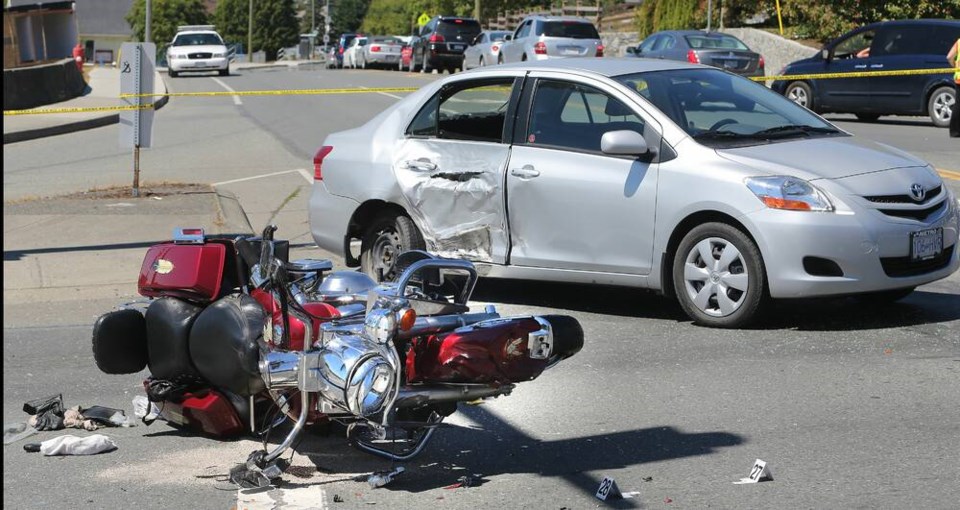Your throttle may be wide open but your margin for living a long happy life is thin. I’m talking about the deadly risks of riding a motorcycle at high speeds — not just in crowded urban streets but on any public road at any time.
It’s as summertime as a melting popsicle — that sound that turns heads on the highway — the scream of high-end motorbikes revving to 8 or 9 thousand RPMs, carving through traffic and disappearing on the long straightaway. Heading back into town this week on the Trans-Canada, I spotted two young kamikazes doing just that.
From the Colwood entrance ramp they zipped, darted and weaved through heavy traffic, one hand only on the handlebars, posturing and flexing for each other as they passed other cars right and left.
They were caught in that motorcycle euphoria that can affect most young men — and it’s mostly men — those feelings of freedom, power and adrenaline. But behind that sound and the helmet, lies a simple brutal truth: high-speed motorcycle riding on public streets is one of the most dangerous activities a person can do.
I often write about distracted, impaired and aggressive driving. High speed motorcycling receives much less attention. I suppose it’s about the image. It’s thrilling, edgy and even cinematic to those who also strap on a GoPro camera to capture their ride. The reality though is not slow motion hero shots. It’s broken bones, shattered helmets and roadside memorials.
Tiny mistakes have massive consequences at 120 km/h or higher as the room for error becomes microscopic. It can be a sideways glance, a twitch in the handlebars or that inevitable car that doesn’t see you coming. At city speeds, a motorcycle rider has a chance. At 120-plus, those errors become life-altering — or life-ending.
Motorcycles lack the protection of cars; no airbags, no seatbelts, no crumple zones. The crumple zone is your body. Even with a full face helmet and proper riding gear the survivability at 120-140 km/h is close to zero. It’s not just crashing either. At those speeds braking distances triple, tire grip drops and the rider’s brain simply cannot process visual information properly — not at 40 metres per second.
Lots of riders will argue, correctly, that modern sportbikes are engineered to handle speed. Their brakes are excellent, the frames are stiff and the tires are sticky. Here’s the newsflash though: all that is for the racetrack and public roads aren’t racetracks. That racetrack you think you are on is filled with distracted drivers, hidden driveways, wildlife, gravel patches and construction sites. That kind of racetrack doesn’t warn you with markers, runoff areas or predictability.
This kind of riding also creates “target fixation.” At high speed, the brain tends to focus narrowly on a single point ahead, reducing peripheral awareness. This kind of tunnel vision means that riders are more likely to miss critical clues like a car’s signal light or a truck suddenly changing lanes.
Chronic motorcycle speeders have succumbed to the illusion of mastery — a feeling of complete control even at 150 km/h. But those illusions can’t combat moments which cannot be seen or predicted. Even 100 metres distant, if a car pulls out in front of a bike doing 150 km/h, the rider has around two seconds to recognize, brake and avoid. At that speed, stopping distance can easily be 120 metres.
The adrenaline rush is a big factor making high-speed riding so addictive. The thrill of acceleration, the sound, the wind and that tunnel-like focus are a natural high. But highs distort judgment which leads to “speed creep,” a kind of dependence on having to go faster and faster. I’ve heard comments like: “I can’t ride slow”, or “if I crash, I crash” from some bikers. The problem is that it’s not all about you. At this stage, these types of riders aren’t just risking themselves, they’re endangering everyone else using the road.
The stats are the epilogue to this story. According to ICBC, motorcyclists make up about 3% of the vehicles on our roads, but they account for 10% of all road fatalities. High speed is a contributing factor in nearly 50% of fatal motorcycle crashes. In many of the injury cases, researchers found that the rider believed they weren’t doing anything wrong. They were simply riding too fast to adapt to the unexpected.
I’m not anti-motorcycle. Riding is rewarding, fun and even joyful. But it has to be approached with respect — for the bike, the road and of course your life.
If you simply covet speed, you need to be on a racetrack — a safe structured environment with proper gear and supports. With a wide open throttle, no matter how good you are, reality always wins.



